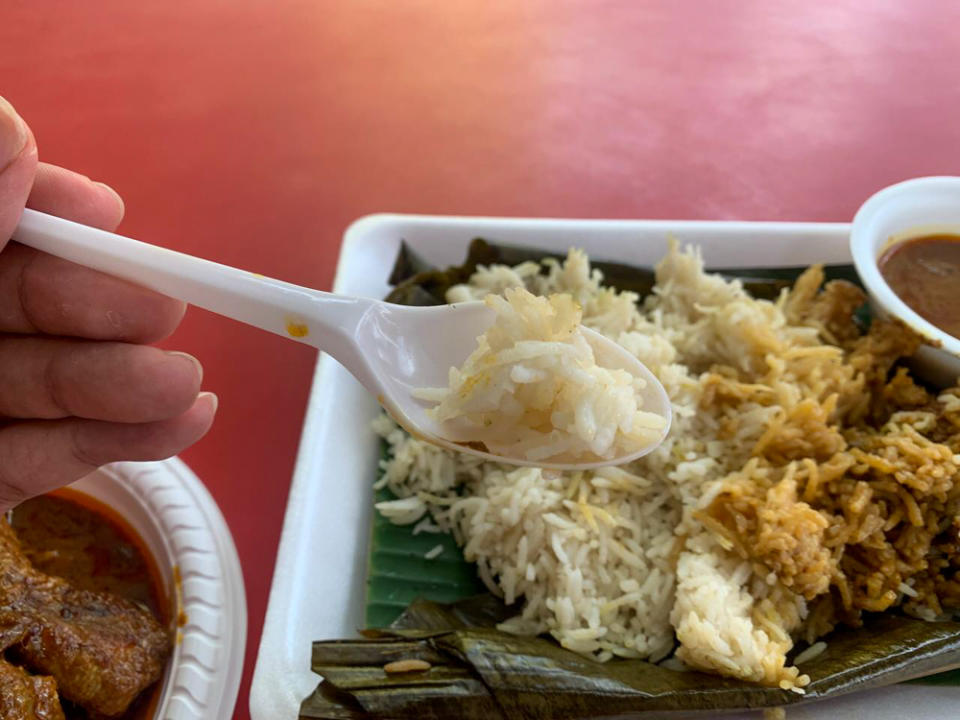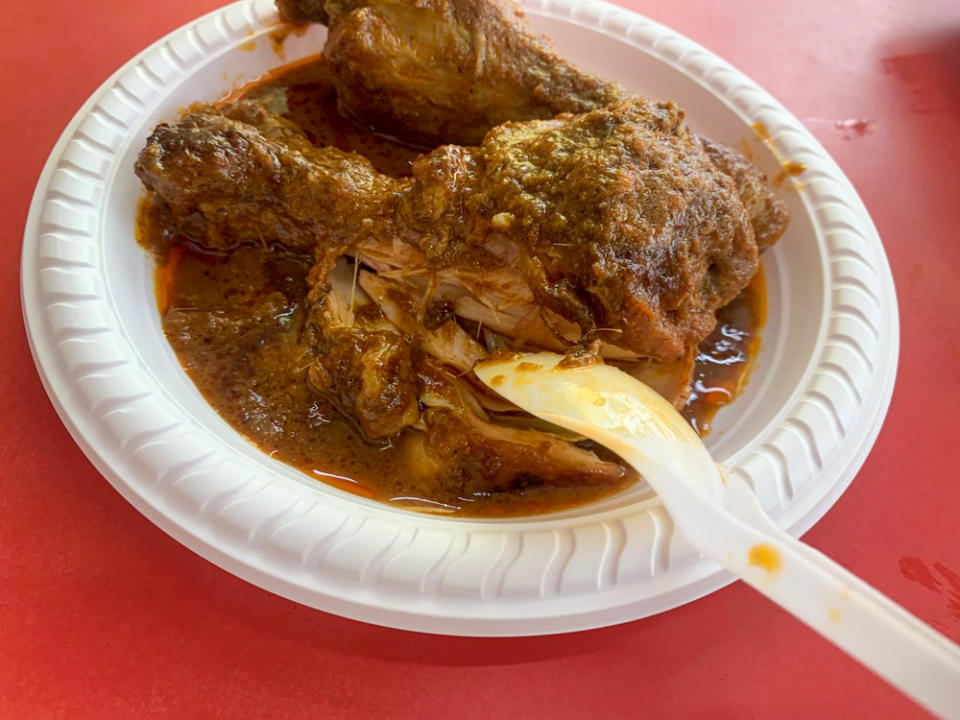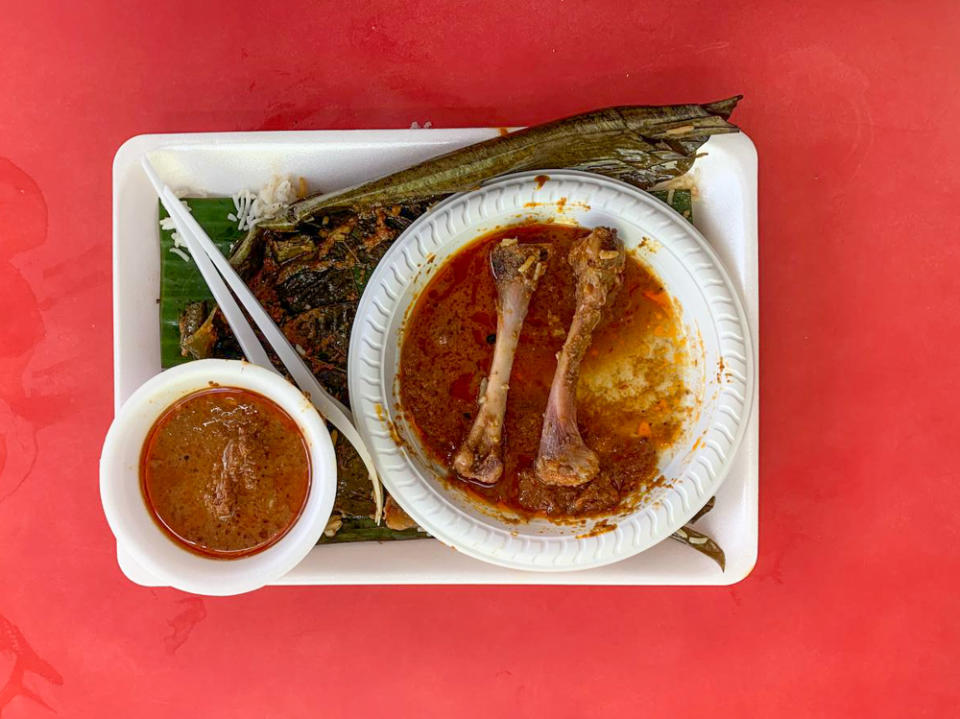Bamboo Nasi Rendang: Traditional nasi rendang cooked in bamboo using family recipe
Ahh, Chinatown… This place is known for being a tourist hot spot, the epicentre of Singapore’s rich Chinese history (after all, it is the site of Singapore’s oldest Chinese temple), having more than 200 Chinese hawkers in Chinatown Complex, and more recently, Bamboo Nasi Rendang.
No, this isn’t an out-of-date National Day-themed menu. Rendang, or more specifically bamboo nasi rendang, has been making waves in Chinatown for its innovative use of the bamboo to enhance the flavours of the nasi rendang.

Bamboo Nasi Rendang is located in Chinatown Complex Food Centre and is run by Mr Murset and his wife. Despite starting out quite recently on 28 Aug 2021, Bamboo Nasi Rendang gained recognition from the public due to its unique cooking method.
Mr Murset cooks his rendang and rice in a piece of bamboo. Before placing the dish in the bamboo, he places daun lerek (phrynium pubinerve) into the bamboo first, which helps to give the rice a special aroma. It is then steamed for three hours before being served.
It is open from 11.30am to 8pm daily. However, the bamboo-cooked items on the menu are limited, which is why Mr Murset recommends coming earlier to avoid disappointment.

This recipe was taught to him by his late mother-in-law, and he sought to share this unique dish with others. Though he mentioned it to be a Hari Raya dish, I’ve personally never heard of such a dish and cooking method despite my 23rd time celebrating it.

Both Outram Park and Chinatown MRT stations are a walk away from reaching Chinatown Complex Food Centre. I strongly encourage paying attention to the stall’s unit number (#02-154) as the food centre is its own labyrinth. I passed by the same mee pok noodle uncle thrice before finding it located along the perimeter of the hawker centre.
What I tried at Bamboo Nasi Rendang
I had the Nasi Rendang Daging with Bamboo (S$7) and a side of Ayam Rendang (S$4).
A Malay staple, Basmati Rice Nasi Lemak, is also available with Ikan (fish) or Ayam (chicken) for S$5. Bamboo Nasi Rendang also sells traditionally-made Lemang (S$10) for a whole tube. It was cooked similarly to its rice and rendang counterpart.

After carefully unwrapping the leaf of the Nasi Rendang Daging, it suddenly occurred to me how much it looked like a giant coke gummy – I certainly haven’t had any rice dish looking like this before! I also noticed that they used basmati rice, which was a nice touch. Despite how odd it looked, my first bite was a familiar one. I understood what Mr Murset meant when he said “special aroma”, as it wasn’t foreign to me.

If you’ve ever had traditional steamed Javanese or Malay kuehs, like the Nagasari and Koci (which are wrapped in banana leaves and steamed), you are probably aware of that distinct leaf-like taste present in both. The rice had hints of that taste and was cooked perfectly.


Unfortunately, the same couldn’t be said for the beef rendang. Firstly, I was disappointed with the amount of beef that I got— I counted a total of a cube and a half of beef. Despite it being easy to cut through using my plastic utensils, chewing it was a different story. It also didn’t help that the flavour of the rendang was muted; the coconut and spice flavours that I expected were but a speculation. Maybe having less is more.

The accompanying curry-like sauce would have helped since there was little to no gravy with the beef rendang, but it tasted slightly off with an unnatural sourness after a few spoonfuls.

I went onto my next dish pessimistically, but was pleasantly taken aback by the gravy, which was miles apart from what I had earlier. Now, this is rendang. In fact, it boggles my mind to think they came from the same kitchen. The lemak (fatty) from the coconut milk was well and alive in this one. Here’s the best part: it wasn’t spicy at all, and I could clearly taste the cloves and star anise that had been used.

The chicken meat was sliding off the bone with just a slight nudge from my flimsy plastic spoon. The mak cik (auntie) was even kind enough to give me two pieces of drumstick as she felt the one I had was too small. The accompanying gravy was also the reason I could finish my meal. This is really a tale of two dishes.
If you were to ask me, my hypothesis would be that the lack of temperature control that happens during steaming caused the beef rendang to be overcooked, and the two glistening chicken drumstick bones on my plate were the only evidence I needed as proof.
Final thoughts

If by any reason I am in Chinatown, I will definitely head to Bamboo Nasi Rendang for my meal, though more for its tasty and affordable rendang rather than its cooking style. The extra aroma didn’t do too much for me and probably was detrimental to the beef.
I do have to praise Mr Murset for sharing a piece of Malay culture that has eluded even myself in a place where you expect carrot cakes and duck rice to be prevalent. I would definitely recommend my peers to at least give Bamboo Nasi Rendang a try for culture’s sake. Me? I’ll just have mine cooked in a pot.
Expected damage: S$5 – S$7 per pax
The post Bamboo Nasi Rendang: Traditional nasi rendang cooked in bamboo using family recipe appeared first on SETHLUI.com.


